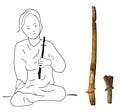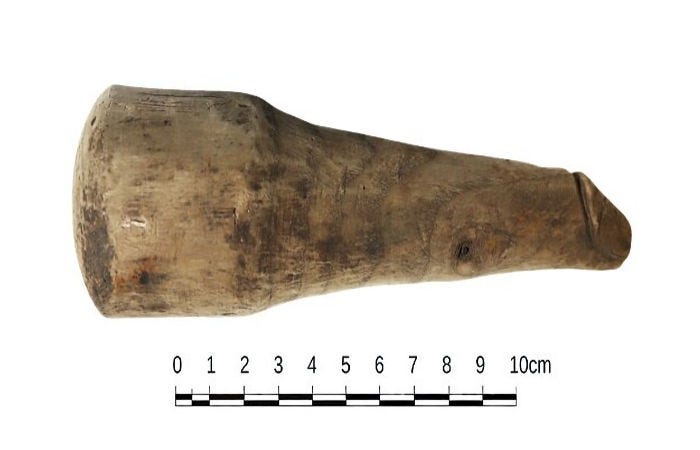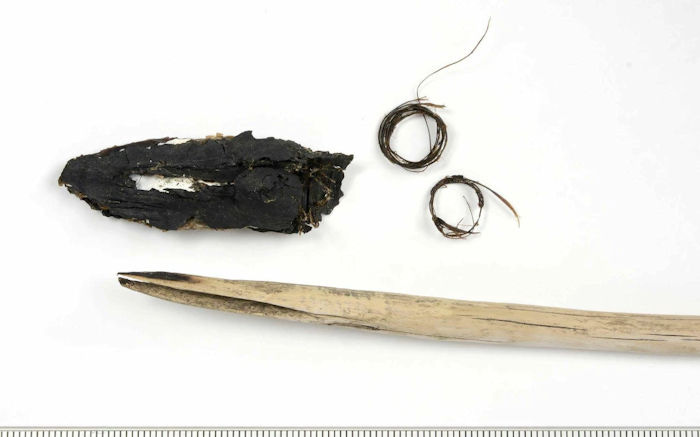🧐 Ancient Beat #49: The domestic lives of monument builders, traveling bows and arrows, and um... suggestive Roman artifacts
Hi folks! Welcome to issue #49 of Ancient Beat. This issue is an important one because Ancient Beat is turning one year old!
Yep, a little over a year ago, I decided it was time for me to start writing about this topic that I love so much. So I created a newsletter and, on February 26, 2022, I sent out my first issue. The content has changed a lot since then, as has the name. I called it “Rhythm of the Ancients”, but that felt like a bit much, so I cut it back to “Ancient Beat” before long — “beat” being a nod to a reporter’s beat, as well as my love for drumming in both the ancient and modern worlds. One year and 48 issues later, we’ve grown into a community of nearly 1,800 enthusiasts!
I’m really proud of Ancient Beat. I love the community we’re building. And I’ve learned so, so much in the process of writing it. I’m really grateful to you all for being a part of it. Thank you!
Now that we’ve had a nice little trip down memory lane, let’s go a little further back in time. Here’s the latest ancient news. 👇
🗞 Ancient News: Top 5
Archaeologists Uncover 2,000-Year-Old Stringed Instrument in Vietnam — A stringed instrument made from a deer antler was discovered in southern Vietnam. It is dated to 2,000 years ago during the time of the pre-Óc Eo culture, making it one of the oldest chordophones ever discovered in Southeast Asia. According to Fredeliza Campos, “It fills the gap between the region’s earliest known musical instruments – lithophones or stone percussion plates – and more modern instruments.” The instrument would have been 14 inches long. It has a hole at the top, which is what got the researchers’ attention since it was probably for a tuning peg. It also has a notched bridge to support the string(s). The antler was one of 600 bone artifacts that were found, and three bronze bells were unearthed as well. Here’s Campos again, “The striking similarities between the artifacts we studied and some stringed instruments that are still being played suggest that traditional Vietnamese music has its origins in the prehistoric past.” The researchers believe it would have been played similarly to today’s K’ný. If you’re not familiar with the K’ný, check this out — it really is worth a listen. The musician’s mouth controls the sound and acts as the resonator.
It’s Not a Darning Tool, It’s a Very Naughty Toy: Roman Dildo Found — What might be the first-ever Roman dildo was misclassified as a darning tool when it was discovered in the Roman fort of Vindolanda in England back in 1992. Hm, where to begin… To say that the artifact was re-analyzed is, perhaps, a bit grandiose. A glance at it will tell you that this is no darning tool. Rob Collins can back me up here, “I have to confess, part of me thinks it’s kind of self-evident that it is a penis. I don’t know who entered it into the catalog. Maybe it was somebody uncomfortable with it or didn’t think the Romans would do such silly things.” But we know that they did, based on artwork depicting it. Despite the headlines you’ll see on the topic, it should be noted that the researchers are not sure that it was, in fact, a sex toy. One possibility that the researchers note is that it could have been used as a pestle. And this lines up with the fact that the 6+ inch phallus has ends (plural) that are worn smooth. Another possibility is that it was slotted into a statue where passersby could touch it for good luck, which was actually quite common at the time. So the “dildo” idea is in question and, personally, as much as I love “first-ever” finds, I’d lean toward the penis-pestle idea. I made my wife a (non-penis) wooden pestle and mortar once, and it really is quite similar. Plus, someone’s gotta say it… Is wood really the material you would choose for a sex toy? 😬
Discovery of 4,500-Year-Old Palace in Iraq May Hold Key to Ancient Civilization — A 4,500-year-old palace and temple have been discovered in Tello, Iraq, where the ancient Sumerian city of Girsu once stood. Girsu was a major administrative center. The site, which was originally discovered in the 19th century, was thought to consist of two large mounds, but a 2021 study used remote sensing to find a large complex that has now been excavated. The palace is known as the Lord Palace of the Kings. The temple is called Eninnu, or the White Thunderbird, and it is dedicated to the Sumerian god, Ninĝirsu. It would have been one of the most important temples in Mesopotamia at one time, and while lost until recently, it was known from inscriptions found around the ancient city. Also found during excavations were 200+ cuneiform tablets.
Archaeologists Find Homes of Europe’s First Monument Builders, and They’re Fortified — It’s difficult to say exactly how people lived during the transition to the Neolithic revolution, but a new discovery sheds some light on that. A 6,300-year-old settlement with two palisades and a ditch was discovered at the site of Le Peu near Charmé, France. The archaeologists responsible for the discovery believe they’ve found rare traces of homes that would have belonged to the people responsible for the earliest monumental stone structures in Europe. In total, there were four wooden buildings inside the palisades and two outside. The structures were large, with areas of roughly 100 square meters, indicating that they could have housed extended family, or perhaps they were meeting places. Based on debris in the postholes, it seems that the walls were wattle-and-daub, and the roofs were thatch or bark. The researchers also found traces of a raised platform in one of the buildings, which might have been used as a kitchen or sleeping area. According to the researchers, the dating of the find debunks the idea that Europe’s stone monuments emerged separately from the construction of large enclosures. Interestingly, according to Vincent Ard, “The use of stones is reserved for the world of the dead. We have no evidence of buildings made of stone here other than the Tusson necropolis.”
Homo Sapiens May Have Brought Archery to Europe About 54,000 Years Ago — A new study suggests that Homo sapiens introduced bows and arrows to Europe on their way out of Africa 54,000 years ago. Researchers analyzed small, triangular stone points that were found at the Grotte Mandrin rock shelter in southern France. By comparing them to modern examples and testing their own points, the researchers found that the smallest points (less than a centimeter in width) could not have pierced animals’ hides without being shot from bows. They also found signs of high-impact damage and wear that indicated they were attached to shafts at the bottom of the stones. The researchers suggest that Homo sapiens at that time hunted with bows and arrows as well as spears, the latter being indicated by bigger stones that were also found. For whatever reason, Neanderthals do not seem to have picked up on the use of bows and arrows. This could be because spears worked better in cold environments where strings snapped easily, or it could be because Neanderthals lacked the requisite visual and spatial abilities. Given what we now know of Neanderthals, I tend to believe it’s the former. It’s worth noting that it is thought that bows and arrows originated in Africa between 80,000 and 60,000 years ago.
That’s it for the free Top 5! If you’re a free subscriber and you’d like to read another 16 stories and 7 recommended pieces of content covering toilets, lost strongholds, AI, brain surgery, the Scythians, the Gerum cloak, unusual arrowheads, and more, sign up for the paid plan below. And if you want access but it’s a little too steep for you right now, just shoot me an email. 😃
🗞 Ancient News: Deep Dive
2,400-Year-Old Toilet Found in China — The lower part of a 2,400-year-old flush toilet was discovered in Yueyang, China. It’s essentially a bowl that was indoors with a pipe that led to a pit outside. Servants would have poured water into the bowl after it was used. And Western Han Dynasty carvings suggest that people would have squatted over the bowl rather than sitting on it. Yes, you read that correctly — someone took the time to carve depictions of people on toilets. The palace where this was unearthed was either used by the first emperor of the Han Dynasty, Liu Bang, or perhaps Qin Xiaogong, or his father Qin Xian’gong. This would be one of the oldest known flushing toilets in the world, though I know of at least one that is older by 300 years.
Archaeologists Find Lost Stronghold of Únětice Culture — Many of you will be familiar with the famous Nebra sky disc, which is attributed to the Únětice culture. Únětice metalwork was distributed widely in the early Bronze Age (2300-1600 BCE). Well, one of their fortified settlements has been discovered in Śmigiel, Poland. It was located on an island promontory in the center of a lake, cut off from land by a deep ditch. It had at least two rows of wooden palisades. And it had an area of 3.7 acres, which could have supported up to 100 people. According to the researchers, it was a metallurgical center and a stronghold of power.
Cemetery Found in Mexico City Reflects Changing Burial Customs — A cemetery was discovered in Chapultepec Forest Garden, a park in Mexico City. It dates to between 1521 and 1620 CE, and marks a transition between indigenous burial customs and those of the Spaniards. According to Aburto Pérez, “Despite the fact that most of the burials presented the same west-east orientation, which alludes to the belief in the resurrection in the Christian faith, their arrangement suggests two types of population: one of indigenous origin, probably Mexica, and another European.” The individuals were buried in a variety of positions. Two were buried with a pre-Hispanic seal and a green obsidian blade. You may remember way back in issue #26, I covered some unexpected findings in the same park.
AI Spots Mesopotamian Archaeological Sites in Satellite Images — I mentioned one fascinating use of artificial intelligence in archaeology in issue #47. Well, here’s another. Apparently, AI is now able to identify sites of Mesopotamian remains with 80% accuracy using satellite imagery, though tests in other areas have been far less effective.
Solving Pompeii's Shattered Puzzles with this Israeli Robot — And here’s another one for AI. Artificial intelligence, along with a robot, will be employed to piece together mosaics from Pompei, which are currently rubble — 15,000 pieces of rubble. The project is expected to take three years. According to Ohad Ben-Shahar, “The computer will present intermediate results to us as necessary, and will ask to consult with a human expert who will determine whether the result is good or whether the computer will have to be adjusted to help put it in the right direction.” The technology also has implications beyond mosaics. It could, for example, piece together broken pottery.
Mediterranean Hunter-Gatherers Relied on Marine Resources More Than Previously Thought — Until now, it was thought that the Mediterranean Sea could not support fishing economies during the Mesolithic period due to low biological productivity. But a new study analyzed the bones of 11 individuals at El Collado in Spain and found that these hunter-gatherers who lived on the Mediterranean coast 9,500 years ago had a strong coastal economy. They relied heavily on marine sources of food, including brackish fish and shellfish. According to Maria Fontanals-Coll, “The evidence presented shows that the lower productivity in the Mediterranean basin didn't have a major impact on the harvestable resources that constituted the diet of El Collado individuals.”
Genomic Study Reveals Signs of TB Adaptation in Ancient Andeans — While it was previously believed that tuberculosis did not exist in South America until Europeans showed up 500 years ago, a new study suggests that indigenous populations in Ecuador adapted to the tuberculosis bacterium long before. Selection for the genes involved in tuberculosis response pathways actually increased 3,000 years ago, a time when agriculture became common in the region. No coincidence there, given that TB is a respiratory pathogen that has an easier time spreading in dense populations.
Pre-Islamic inscriptions, rare archaeological finds discovered in Saudi Arabia — Musnad (an ancient South Arabian script) inscriptions were discovered at Al Ukhdud in Najran, Saudi Arabia. The inscription, which is in granite, is the longest Musnad inscription found in the region. Also unearthed were three golden butterfly-shaped rings and a bronze bust of a bull. The finds are believed to be pre-Islamic.
New Findings Unveil Qin-era Ceremonial Rites — Outer walls and a number of architectural ruins have been excavated at the site of Sijiaoping in China, an intentionally flattened mountain top with a ceremonial structure on it. The site consists of an earthen terrace with structures on each of the four corners. This would have been an important ceremonial structure during the Qin dynasty in the 3rd century BCE. The site is well-designed and includes drainage. According to Hou Hongwei, “We can clarify that there was a three-tier structure within the compound. That indicates the rigid ritual system.”
Archaeologists in Italy Unearth 2,000-Year-Old Hall Where Emperor & Knights Used to Party — A large hall was discovered in Naples, Italy in the villa of Vedius Pollio, a Roman knight, wine merchant, and politician. Dating still needs to be done, but the hall probably dates back over 2,000 years to the late Republican age or the Augustan age. Here’s a macabre tidbit: Apparently, Pollio was known for feeding the enslaved people that he held to lampreys when they displeased him. When an enslaved person broke an expensive crystal cup while Emperor Augustus was present, Pollio tried to do so, but Augustus stopped him, had all the crystal cups broken, and, according to some sources, ordered that the lamprey pool be filled in.
Excavations in Poland have Uncovered a Jewish Mikveh — A 300-year-old Jewish mikveh (a bath used for ritual immersion) was discovered in Oświęcim, Poland. It is wooden and was likely connected to a naturally occurring water source like a spring.
Chaco Canyon Mystery Solved by Scientists Hauling Logs on Their Heads — A professor and a student set out to solve a mystery that has baffled archaeologists for decades: How 200,000 heavy construction timbers were transported over 60 miles to Chaco Canyon in what is modern-day New Mexico, USA. To do this, they trained for 3 months and eventually carried a 130-pound log 15 miles by strapping it to their heads. These straps, known as tumplines, employ the bones of the neck and spine rather than muscles to carry heavy weights, and they are depicted in ceramic effigies that were discovered near Chaco Canyon. The professor and student also used sticks called “tokmas” that are used by Nepalese sherpas to take breaks, resting the weight on them without lowering it to the ground. It doesn’t mean this is what these ancient people did, but it shows how it could have been possible.
Nail Hole in the Skull of a Woman Buried Face Down in the 3rd Century BC — A 3rd-century-BCE burial was found in a tomb in the Necropolis of Monte Luna in Sardinia. In it were the remains of a woman buried face-down with a nail hole in her head. The skull has been analyzed and it seems as though she died during an epileptic seizure. And the nail was driven in as she was dying. According to the researchers involved, those who drove the nail and buried her face down were probably trying to prevent the woman’s ailment from spreading to the rest of the community.
Hidden from the Romans: 200 Tons of Silver on the Shores of the River Lahn — Feel free to ignore the title of this article, which doesn’t really convey the point of the study. Yes, the Romans did some mining and missed an impressive vein of silver. But the crux of this study is that an archaeologist went to sites near Bad Ems, Germany, which had offered very little in the way of wood, and on his second-to-last day there, he discovered a wooden defense structure made up of well-preserved wooden stakes. This type of structure is noted by Caesar, but no examples have been found until now. Also, the theory that Roman smelting works were once located at the site was disproved by the researchers because the supposed furnace that indicated the smelting works turned out to be a small military camp’s watchtower which they burned before leaving camp.
Archaeologists Uncover Early Evidence of Brain Surgery in Ancient Near East — I covered medieval trephination in issue #48, but here’s another example, and this one is much older. Trephination is a procedure where a hole is cut into the skull, and it was practiced all over the world. Now, a 3,500-year-old case of the procedure has been discovered in the ancient city of Megiddo, Israel, making it the earliest known example in the Near East. According to Rachel Kalisher, “We have evidence that trephination has been this universal, widespread type of surgery for thousands of years. But in the Near East, we don't see it so often—there are only about a dozen examples of trephination in this entire region.” The man underwent the procedure and died shortly thereafter. Kalisher again, “In antiquity, there was a lot more tolerance and a lot more care than people might think. We have evidence literally from the time of Neanderthals that people have provided care for one another, even in challenging circumstances. I'm not trying to say it was all kumbaya—there were sex- and class-based divisions. But in the past, people were still people.”
Surprising Discovery of Unique 3,500-Year-Old Arrowheads Made of Shells in the Jotunheimen Mountains — Three arrowheads made from freshwater pearl mussel shells were preserved in Norwegian ice until recently. Researchers also found shafts that likely once more shell arrowheads. This type of arrowhead was only in use for a couple of hundred years, from 3,700 to 3,500 years ago, and they are unique to this part of the world. It’s a mystery why they used shells instead of stones, bones, or antlers. That said, as the researchers pointed out, mussel shells are sharp and probably served quite well.
.
❤️ Recommended Content
Never thought I’d say this, but those clay tablets do look tasty.
Many of us in the US are experiencing quite a winter storm right now, so it seems like an appropriate time for this article, which details how ancient humans were able to cope with the cold.
Here’s a video about India’s lost port of Muziris.
Here’s something you probably haven’t considered before — when did people start using drinking straws? This article talks about some 5,000-year-old straws made of gold and silver that were found as burial goods. And they aren’t even the oldest.
If you’re interested in the Scythians (and who isn’t?), here’s a quick article about their art and what made them so fearsome.
Here’s an article about the Gerum cloak, which dates back 2,500 years. It describes a fascinating investigation into the garment, and I must say it’s amazing how much information a cloak can hold.
There’s been a lot of talk lately about the peopling of the Americas, particularly with the new study I covered in issue #47. Well, here’s an article that sums it up nicely.
Well, that’ll do it for this week. As always, let me know your thoughts!
And until next time, thanks for joining me.
-James
Twitter: @jamesofthedrum
P.S. If you like what you’re seeing, please consider forwarding it to a friend. It would mean a lot! 🙏







